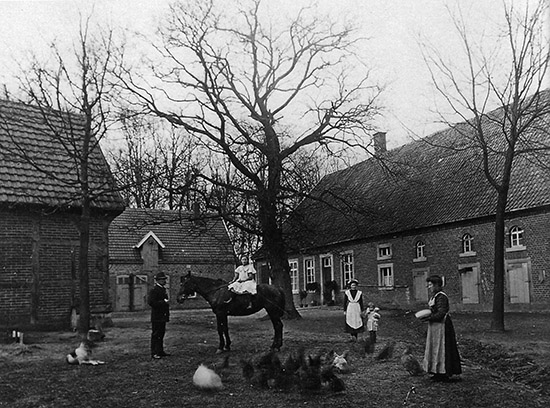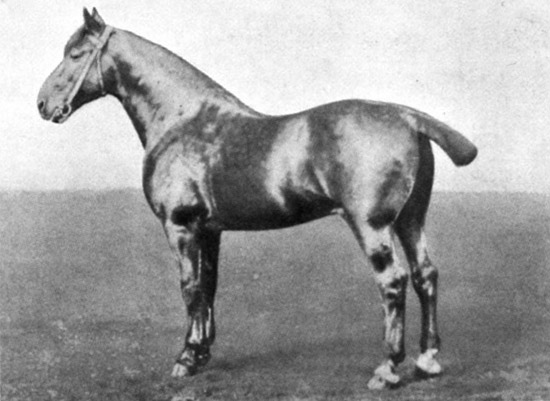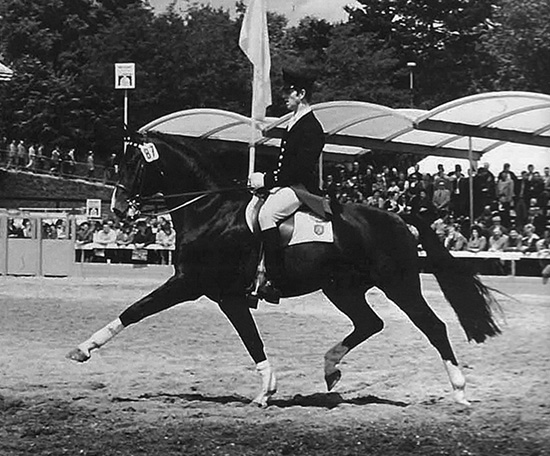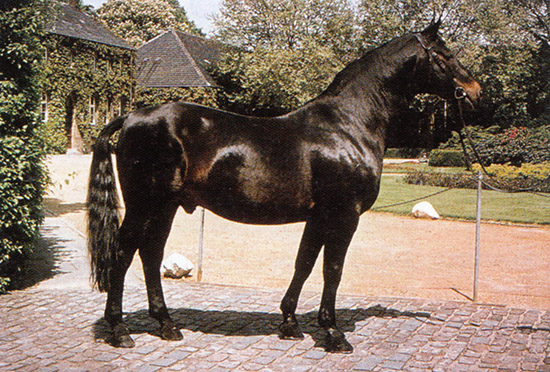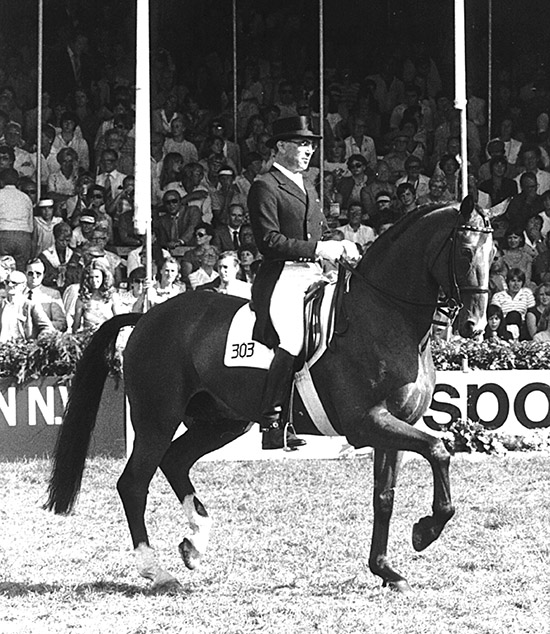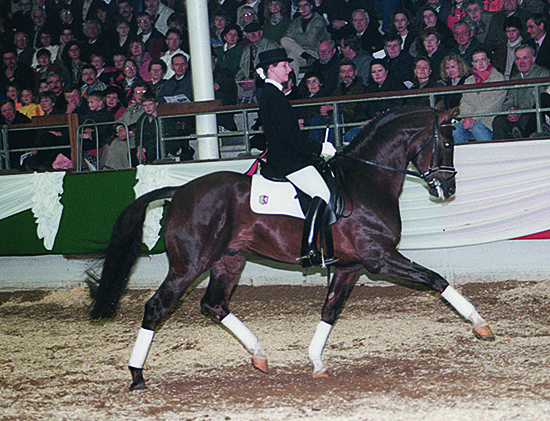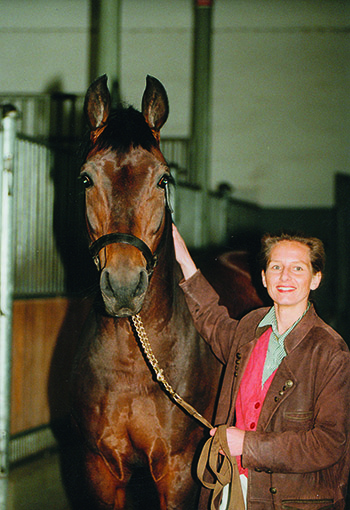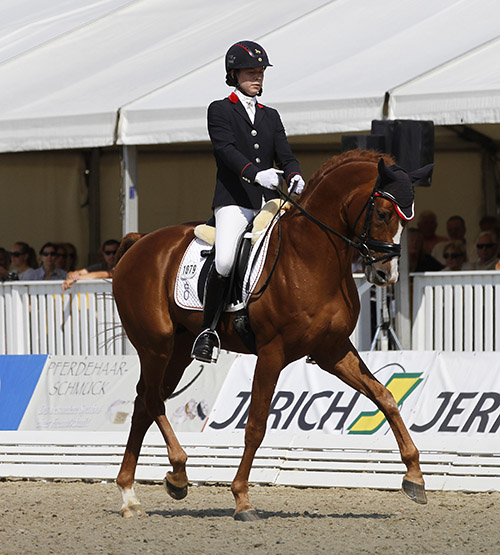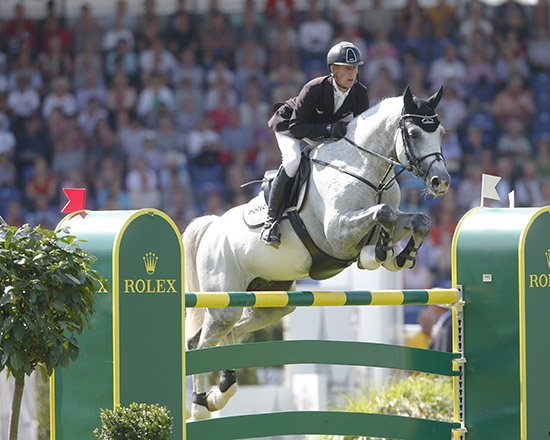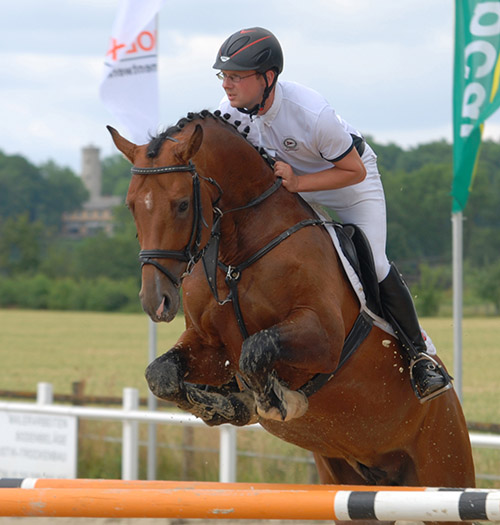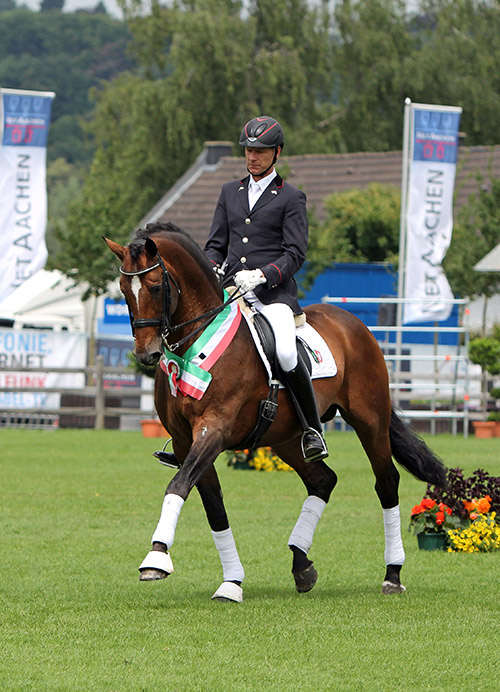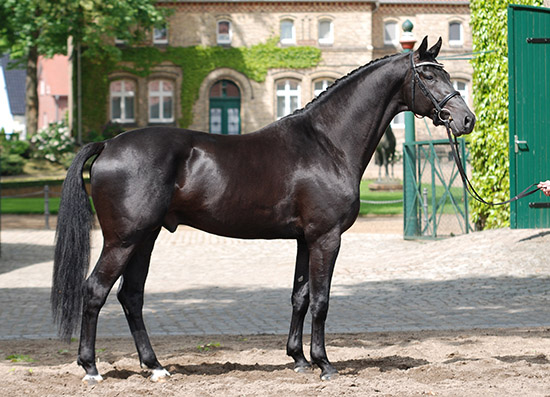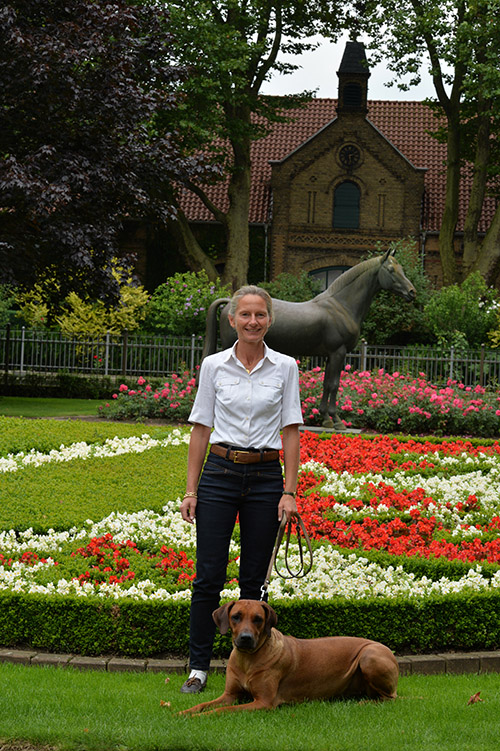Warendorf, the centre of Westfalien breeding, has a history of Warmblood breeding that goes back to 1826, when 13 East Prussian stallions were made available to the local breeders. By 1830, thirty stallions stood at Warendorf. The decline of the cavalry, once again swung the balance in the direction of the heavier farm horse in the latter nineteenth century and the Westfalien became a cocktail of Oldenburg, East Friesian, Hanoverian, Anglo-Norman and Trotter blood. In the 1920’s it was decided to concentrate on Hanoverian bloodlines, and the modern Westfalien began to emerge.
One of the older style of stallions – Excellenz
A number of stallions were instrumental in this process: Frühling (born 1960 and by Frühschein I) from the Hanoverian ‘F’ line and the descendants of the Anglo Arab, Ramzes – Romadour I and Romadour II (although there is a little speculation over the II’s parentage).
The dressage foundation sire – Romadour II
To these were added to some key Thoroughbred stallions: Papayer xx (by Persian Gulf) established a line through Paradox I and II and the ‘P’ line of Pluchino xx, sire of Perseus the sire of Pilatus.
Frühling – one of the influential stallions
By the mid-seventies the results of this classic modern blend were very visible: Gerd Wiltfang’s World Champion showjumper, Roman, was by Romadour I, Frühlingstraum II sired Norbert Koof’s World Champion jumper, Fire. Magister (Milan), Goby (Granit) and Fregola (Frühlingstraum) were all members of the German Nations Cup jumping team. Three Westfaliens jumped at the Los Angeles Games – Ramzes (by Ramiro) for Germany, Gonzo (by Goldlack) for Argentina and Purlex (by Wohlklang) for Japan.
The great Ahlerich
In the dressage at LA, it was the Westfalien, Ahlerich (by Angelo xx) who took individual and team gold, with three more Westfaliens competing – Amon (Ahlerich’s full-brother) for Holland, Satchmo (by Sinus xx) for Canada and Civian (by Cyrian) for Mexico.
Nicole Uphoff and Rembrandt – Westfalia stars in the dressage arena
Other dressage stars included Nicole Uphoff’s World and Olympic Champion, Rembrandt (by Romadour I and out of a full-sister to Amon and Ahlerich), Ganimedes (by Grünhorn) with Monica Theodorescu and Robert Dover’s Romantico (by Romadour II).
From 1978 to 1996, Westphalia produced the following European, World, Olympic or World Cup Champions: Gert Wiltfang’s Roman, Reiner Klimke’s Ahlerich, Norbert Koof’s Fire, Leslie Burr’s McLain, Nicole Uphoff’s Rembrandt, Monica Theodorescu’s Ganimedes, Wolfgang Brinkmann’s Bugati Pedro, Klaus Balkenhol’s Goldstern, Isabell Werth’s Fabienne, Lesley McNaught-Mändli’s Pirol, Thomas Fuchs’ Dylano, Dirk Hafemeister’s PS Priamos and Martin Schaudt’s Durgo.
Susanne Schmitt-Rimkus and Fidermark
Westfalia also produced something of a seismic shock on the German breeding scene when in June 1996 they appointed Susanne Rimkus (now Schmitt-Rimkus) Director of the Westfalien National Stud (or to give it the proper title, Das Nordrhein-Westfälische Landgestüt), at a time when it was easy to work out who the stud director was, he was invariably the largest male person in the room…
Young, attractive and female, Susanne actually rides the stallions (to Grand Prix dressage level) and when she wants to show you a stallion, she darts into the tack room, puts the halter on the horse and leads it out, herself. More recently Dr Astrid von Velsen-Zerweck, was appointed director at Marbach, but Frau Rimkus was the trail-blazer. Since then, she has married and become Susanne Schmitt-Rimkus.
Interviewed in 1999, Susanne had the air of someone well and truly on top of her job, and was looking to breed an all round horse:
Susanne Schmitt-Rimkus and the great Florestan
“Here in Nordrhein-Westphalia, we aim to breed a horse which moves well, which is a comfort to ride, and also able to jump. Not a specialist – but we feel we can find the specialists amongst these horses.”
“Most of our buyers ride in their spare time, they can feel confident when they buy our horses that even if they jump at the weekend, they have to ride dressage during the week, or during the winter, and that has to feel nice for them. They want to have a horse that is nice to work with, and can jump.”
Susanne is the head of the State Stud Warendorf, which is responsible for the state of Nordrhein-Westfalen, and its two studbooks, Rheinland and Westfalien: “Formerly they were two separate organizations but now they are coming together more and more. The main licensing of the two and a half year old stallions is in Münster for both stud books. They have a commission with representatives of both studbooks, but mare selection and the foal shows, they do separately. Our national stud is responsible to both.”
“Our breed is based on Hanoverian blood. In former times our studbook changed from heavy horses to Warmbloods with the help of the Hanoverian bloodlines. The change was made after the Second World War. It was my predecessor, Dr Gerd Lehmann who did great work in changing the horses over to more sport horse types. This is one of our important tasks.”
“I look at several licensings in different areas for stallions for our studbook. Of course the Nordrhein-Westfalien licensing is the most important for me, but then I look in Hanover, in Holstein – although I haven’t bought a Holsteiner yet – and the Trakehners, we only have one Trakehner stallion at the moment, and for many years there were none. I think about using Trakehner blood for elegance and type, like the Thoroughbred. The Hanoverian licensing is the most important after our own, and we look at Oldenburg because in Oldenburg there are many bloodlines… but again I haven’t bought an Oldenburger stallion yet, just Hanoverians.”
“We have a few Thoroughbred stallions, but not enough. Today it is very important to show our breeders that you can ride Thoroughbreds; that they are good riding horses. Formerly they were just shown in hand, and they would be leaping and bounding all over the place and the breeders were afraid to use them because they thought they would get nervous horses. I try to show the Thoroughbreds under saddle, and if I buy new Thoroughbreds, I test them here at the National Stud before buying them.”
“Only after I ride them do I decide. You need so much time to look at the racecourses to find the right Thoroughbreds. They are many that are not suitable in their construction, more and more they are breeding Thoroughbreds that are high and big behind, with the neck downhill, like a Quarter horse, and that is not what we need for the Warmblood horse.”
“I am always looking for Thoroughbreds that are built uphill, and that is not too easy to find. If they come from the racecourse, then usually they cannot trot. Our Thoroughbred stallion, Conception, when he came here, he could not trot very well, but as I have seen many Thoroughbreds, and I rode Thoroughbreds at the racecourse myself, I could imagine that he must be able to trot after some training, and now he trots really well. He is also very talented for piaffe/passage and I hope to educate him up to Grand Prix. You have to find Thoroughbreds that are like that.”
“Although we have our State Stallions, we also have many private stallions. In the Nordrheinland, we have many more private stallions, but while they have more stallions, the State stallions cover more mares. Most of the breeders trust the State stallions. We have twenty-eight deckstations where we send our stallions. They go out at the beginning of February and come back at the end of July.”
“Most of our stallions cover the mares naturally – then we have twenty to twenty five stallions which are for artificial insemination. Our station here at Warendorf is the main insemination centre. I like our stallions to cover naturally because I pay close attention to maintaining our bloodlines. If I have too many stallions available with AI, then the breeders will concentrate on them. I think it is one of the strengths of Westfalien breeding that we have so many bloodlines, then if we bring in outside blood – Holstein for instance – we can select from our own bloodlines the mares that will be suitable because we have such a variety to choose from.”
And your own background, has it always been with horses?
“I have always been with horses. I had some education as an amateur instructor, then I studied Agriculture, specialising in animal breeding and feeding. As I have always been interested in horses, that’s where I specialised, but because there are not many jobs with horses, I then worked with cows and pigs.”
“I taught people in the ‘new’ Germany, the eastern part, teaching the management of cows and pigs, and I learned then to be able to operate with a lot of older men who were the heads of farms there.”
“After that I worked for three months at the Holsteiner centre at Elmshorn, working with the stallions, I knew Landgraf, and Lord.”
“Then I moved to Warendorf, to the National Federation. We have the only national federation for both sport and breeding, and the National Federation is the umbrella organization for all our stud books, we have more than 26 studbooks in Germany. I was in the breeding department and learned a lot about the structure of horse breeding, and I had the contact with the National Stud in Warendorf, and so I got the job here.”
That was a big challenge?
“It was, it was the big chance, there are only nine state studs in Germany and most of them do not change their directors very often. It happened…”
Your long term goals?
“The biggest plan is to breed good horses, and that has been the goal of every director before me. As I am a woman, I look closely at the handling of the horses, I hope we will have modern easy-to-handle horses which move well and are not just specialists in one discipline – they should be able to compete in dressage and jumping at level L, and out of those you can find the specially talented horses. I hope that many many people will feel comfortable on our horses.”
The National Stud is an impressive complex and is also the home of the German Riding School which was established in 1888. Stallions who fall from favor – either because their foals are not up to standard, or if the ‘type’ doesn’t please the breeders – find their way to another barn where the school stallions live the life of an honest riding horse in the Riding School.
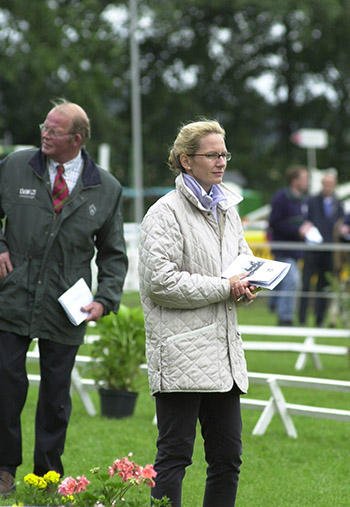
Update: 2014 with Susanne Schmitt-Rimkus
It is always a joy to catch up with the director of the Westfalen State Stud at Warendorf, if for no other reason than it provides an excuse to walk through this most beautiful of studs, with its historic buildings and imposing trees. In fact, we are strolling in the direction of the director’s office when we come across the director herself, and one of her assistants, and it looks very much as if they are in the process of selling a horse to a couple of visitors to the stud. Susanne is very much the hands-on director, a contrast to the lofty god-like gentlemen who headed up the state studs before she became the first woman director… now with the appointment of 32-year-old Dr Carina Krumbiegel to the position at Baden-Wüttemberg, along with Dr Astrid von Velsen-Zereweck at Marbach, there are three women directors in the German State Stud system… and state stallions compete!
Susanne has just finished judging a round of foal shows, and is aglow with enthusiasm for the progeny of the new dressage star she has discovered.
“The foals that have made our commission most enthusiastic, have been the foals of Sir Heinrich, a son of Sir Donnerhall from a Fürst Heinrich mother. Sir Heinrich is six years old now, and he has really really exciting foals, out of different mares. The gaits, walk, trot and canter, everything… conformation. The stallion himself is quite a small, tiny stallion, and when I bought him, the breeding commission at the licensing said, ‘oh what do you want with this pony?’ But they gave him the chance. He won the performance test, second from all over Germany, then he was vice champion at the Bundeschampionate at the age of five, and went on to the world championship. This year, he also qualified for the six-year-old championship at the Bundeschampionate, and he is the first reserve for the World Championship.”
Sir Heinrich wins at the Young Horse Championships in Verden
“I found him at the stable of Heinrich Ramsbrock. The breeder is Paul Wendeln, I think many people know him – he is a well known breeder in Oldenburg. The mother family was the winner of the German championship of breeding mares, some years ago, and it is a really good mother line. Paul Wendeln did not prepare the stallion for the licensing because he was so tiny, and Heinrich Ramsbrock saw this colt and he fell in love with him. When we came to his place to select stallions for our stud, Sir Heinrich had been there just one day. After we’d seen a lot of stallions, he said, ‘oh I have another one, I will show you’ and Sir Heinrich came in and immediately we were taken with this horse. He was cantering, he was trotting, he stood there, and we said ‘we want to buy this stallion. And at once!”
“Mr Ramsbrock was so happy that there was another person who would fall in love with this horse – he’s a very emotional person, so we could buy him for a very good price.”
And he’s crossing well over a lot of different mares…
“This is really interesting. You know in former times, when we had breeders who might have been beginners, and they didn’t know much about their mares, we could always say ‘use Florestan’, because Florestan is very safe and produced really a high percentage of foals that were similar to Florestan. Now unfortunately Florestan is dead – okay he had a good long life – and Sir Heinrich may step into his hooves, because we again can tell the breeder, if you use this stallion for your mare, you have a very sure prediction that the foal will be in this or that conformation…”
And not small?
“No, not small. The first thing the breeders noticed when the foals were born, was, wow, they are not small!”
Cornado NRW, flying the flag for Westfalia
With the jumpers, which stallions are impressive?
“The champion for us is Cornado NRW, who is very successfully competing at an international level with Marcus Ehning. This is also very good – he is not just a good sporthorse, he is a good sire. His foals are very elastic, very good types. He himself is a very nice type – and they are very sportif foals. Of course he is one of my favorites, but of course he does not have so many foals because he is so busy competing that we don’t that much semen. We have many breeders who want to use him, or they used frozen semen this year – from France, from Belgium, where he was competing very successfully.”
“With the younger stallions, there is one very interesting stallion, Cup Cooper, a son of Cooper van de Heffinck, then Clinton/Ramiro. He is a five-year-old Belgian stallion and he has very very typey foals with very good muscles, they are so strong, and when they canter they have such presence. He doesn’t have many foals because he is a young stallion, and at the moment it is very difficult to get mares for young stallions. I saw about 20 foals this year from this young stallion, they are all in one shape – you can see immediately, ‘oh it’s a Cup Cooper’. Really good foals – and he is also competing really well.”
One of the young stallions – Cup Cooper
Has that been one of the most successful things you have done as the Director – you got the jumping stallions out competing…
“It belongs to my time here at the stud, and I think it is a very important development. Today, we couldn’t manage stallions without competing – all our young stallions, dressage and jumping, are in competition. They start usually at the age of four, and then it goes until they are too old for sport, or are not used by the breeders any more. When I started it was a really imported goal for me, that all stallions had a chance to compete. It meant getting riders here who are able to compete and to train and educate the stallions. I have been quite lucky with this.”
Quite lucky, or someone with the foresight to see what needed to happen…
“Both I hope,” Susanne laughs. “But I am sitting on a horse every day still. Usually I ride one, two stallions. At the moment I am riding a three-year-old, but usually I ride the older ones, and this is very important. To keep the feeling for riding – so when I watch a foal, or a two-year-old stallion, I try to feel how it is to ride him, even with a foal when it starts to move. There are gaits that might be spectacular, but when I think about riding them, I think oh my god! For me it is important to keep this connection between riding and breeding.”
Which is your favorite stallion?
“This is very difficult to say… it may depend on quality, or on the personal contact. If we are talking about personal contact, I will say Laureus, the son of Laurentianer. In one of our previous interviews, we made a story about Laurentianer, and now Laureus is his first licensed son, who went on to win the licensing. This was a great success for me because Laurentianer was one of the first stallions I bought, and to have his first son a winner…. Laureus has a very good character, he is our most successful dressage horse, with more than 45 dressage placings. But he is also a great character, for me he is a friend, this is a really close connection I have to this horse. There may be others with higher quality but this one is my personal favorite.”
A personal favorite – Laureus
On a more depressing note, I have been talking to many people in many breeding areas across Europe and they are all talking about the down-turn in breeding, with up to 50% less mares being bred…
“It is really difficult. Last year, fortunately, we didn’t lose any, so we had the same number as the year before. But we had one stallion, All At Once – this is typical for our times – a three year old, and last year he covered more than 400 mares! He saved our numbers, this year he has about 150/160, still a lot, but not that high any longer.”
Does that make you uncomfortable, with a young stallion covering so many mares?
“Yes, because you don’t know anything about the stallion, you don’t know which mare bloodline. He is black and very pretty, his father is Ampère and his mother, Gribaldi, and since Totilas, with Gribaldi, everything is good. There is no stallion that fits with all bloodlines, and the danger is that a stallion covers a lot of mares that don’t fit with him. It’s not good for the breeder, of course, when he doesn’t have a good foal, and for the stallion, it’s not good because when he covers many mares, there are also many not-so-good foals, and these are the foals the people talk about.”
All At Once – by Ampère, out of a Gribaldi / Jazz / Contango mare… 400 mares!
“The older stallions, where you have really good information, nobody wants – I can’t understand this, it just doesn’t make sense. The breeders think ‘oh, the first year, and the black stallion, I want to be one of the first with a foal’, but there are more than 300 foals, and if you have one not-so-good, then it is nearly impossible to sell it. But we can’t stop it, we can’t say no, we need the mares and we need the money. This is a leased stallion, I can’t go to the owner and say, oh I told these mare owners that they should not use your stallion. I am not comfortable with this, but I can’t help the breeders, when they don’t want to know, we have to accept it. Maybe it will change when lots of breeders have learnt from their experience.”
After the WEG, the last stallions of the once mighty French National Stud will be auctioned and the studs will be empty, in Sweden, Flyinge is no more, will the great studs of Germany survive?
“Difficult question. I have had to cope with this question since I started here. Every year somebody comes and says, ‘do we need a national stud?’ The structure we have in Germany is not the same as France, we are responsibility of the different states of Germany, so there will not be a decision, all the studs in Germany will close. There are different governments responsible for the various studs. All the ten studs in Germany have worked very closely together for a number of years, since there are some younger directors, but also the others, like Jurgen Müller from Neustadt-Doss, he’s a very good friend of ours, and we work together closely where it makes sense. We can’t work together on everything because okay, every stud director wants their stallions to be used, but we work together to shape public opinion and making people aware of the heritage and place of the national studs. Every government will decide for itself, so there are already some studs that are more an object of culture and tourism, and there are others, like Warendorf or Celle, where breeding is still the main point – then there are some where the riding school is very important, like Redefin, where they have put a lot of money into the development of riding tourism. So the governments try to find their own way to keep the national studs, and we can just hope that we survive, but we have survived for more than 180 years, the stud survived two World Wars, and it is unbelievable that now when people are better off than ever before, that we cannot save these monuments of culture.”
Jurgen Müller retires next year, you have no intention of retiring?
“No, no, I am still too young. I started at the age of 31 and I have been here for 19 years, it is a long time but as I started so young I have a few more years before I have to think about retirement, and at the moment, I love my job, it’s more than a job, it’s also my life. I hope that I can give the stud a future. My intention is to give the stud to the next person as a very good and safe place to work, but I don’t know what happens…”

